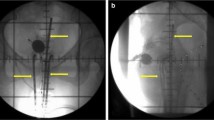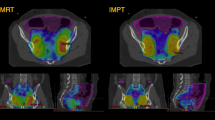Purpose:
The article focuses on the treatment and protective effects of hypoxyradiotherapy during external-beam irradiation of cervical carcinoma, including paraaortic lymph nodes, combining radiotherapy with californium-252 (252Cf) neutron brachytherapy. An analysis of treatment results, early and late side effects and complications is presented.
Patients and Methods:
From January 1989 to May 1997, 307 women with stage IIb and IIIb cervical carcinoma, treated with 252Cf neutron brachytherapy, were randomly divided into two groups and treated with external-beam irradiation to the paraaortic lymph nodes as follows:
• 155 patients (59 with stage IIb, 96 with stage IIIb) were treated by external-beam irradiation administered as a 60-Gy dose applied under conditions of acute hypoxia; 77 patients (30 with stage IIb and 47 with stage IIIb) received extended-field irradiation up to L4 and 78 patients (29 with stage IIb and 49 with stage IIIb) up to T12.
• 152 patients (58 with stage IIb, 94 with stage IIIb) were treated by external-beam irradiation administered as a 40-Gy dose applied under normal oxygenation conditions. 73 patients (29 with stage IIb and 44 with stage IIIb) received extended-field irradiaton up to L4 and 79 patients (29 with stage IIb and 50 with stage IIIb) up to T12. The same 56 Gy-equivalent (eq) doses at point A and 19 Gy-eq doses at point B were applied intracavitarily in both groups. The total radiation doses at points A and B were 99 and 79 Gy-eq, respectively, for patients treated with external-beam irradiation to 60 Gy under conditions of acute hypoxia. For patients treated with external-beam irradiation to 40 Gy under normal oxygenation conditions, the doses at points A and B were 85 and 59 Gy-eq, respectively.
Results:
The 5-year overall survival rate for all patients (stages IIb and IIIb) was 7.0% better for patients treated in acute hypoxia than for patients treated under normal oxygenation conditions (78.7% vs. 71.7% [p < 0.16]). The 5-year metastases-free survival rate was better by 11.7% for stage IIIb patients in the hypoxyradiotherapy group with extended field up to T12 as compared to patients with extended field up to L4 (97.4% vs. 85.7% [p < 0.05]). Comparison of metastases-free survival rate of stage IIIb patients after external-beam irradiation with extended field up to T12 in hypoxic condition versus normoxic condition showed a 12% better result for patients in hypoxic condition (97.4% vs. 85.4% [p < 0.04]). Occurrences of symptomatic radiation-induced reactions during or shortly after irradiation were more frequently observed in patients treated with a lower dose under normoxic conditions. During the period of 6-12 years after treatment there were no changes in the frequencies of occurrences of late effects and complications.
Conclusion:
The importance of the protective effects of hypoxyradiotherapy for dose escalation in external-beam irradiation of cervical carcinoma, including paraaortic lymph nodes, with regard to an improvement of the cure rates of metastases in paraaortic lymph nodes has been confirmed.
Ziel:
Untersuchung der protektiven Wirkung der Hypoxieradiotherapie im Rahmen der perkutanen Bestrahlung des Zervixkarzinoms einschließlich der paraaortalen Lymphknoten, wobei die perkutane Strahlentherapie mit Californium-252-(252-Cf-)Neutronenbrachytherapie kombiniert wurde. Eine Analyse der Behandlungsergebnisse einschließlich der akut und spät aufgetretenen Nebenwirkungen wird präsentiert.
Patienten und Methodik:
Zwischen Januar 1985 und Mai 1997 wurden insgesamt 307 Patientinnen mit Zervixkarzinom Stadium IIb und IIIb, die sich einer 252Cf-Neutronenbrachytherapie unterzogen, wie folgt randomisiert und behandelt:
• 155 Patientinnen (59 im Stadium IIb, 96 Stadium III) erhielten eine perkutane Bestrahlung bis 60 Gy unter Bedingungen der akuten Hypoxie. Bei 77 Patientinnen (30 im Stadium II und 47 im Stadium IIIb) wurden die paraaortalen Lymphknoten bis auf Höhe L4 bestrahlt, bei 78 Patientinnen (29 im Stadium IIb und 49 im Stadium IIIb) bis auf Höhe Th12.
• 152 Patientinnen (58 im Stadium IIb und 94 in Stadium IIIb) erhielten eine perkutane Bestrahlung bis zu einer Gesamtreferenzdosis von 40 Gy unter normoxischen Bedingungen. Bei 73 Patientinnen (29 im Stadium IIb und 44 im Stadium IIIb) wurden die paraaortalen Lymphknoten bis auf Höhe L4 bestrahlt, bei 79 Patientinnen (29 im Stadium IIb und 50 im Stadium IIIb) bis auf Höhe Th12. In beiden Gruppen wurden die gleichen 56 Gy-Äquivalent-(Äq)-Dosen in Punkt A und 19 Gy-Äq in Punkt B intrakavitär verabreicht. Die Gesamtdosen in Punkt A und B betrugen 99 und 79 GyÄq für Patientinnen, die mit perkutaner Bestrahlung bis 60 Gy unter Bedingungen der akuten Hypoxie behandelt wurden. Für Patientinnen, die eine perkutane Bestrahlung bis 40 Gy-Äq unter normoxischen Bedingungen erhielten, betrugen die Dosen in Punkt A und B 85 und 59 Gy-Äq.
Ergebnisse:
Die 5-Jahres-Gesamtüberlebensrate aller Patientinnen (Stadium IIb und IIIb) war für Patientinnen, die in akuter Hypoxie behandelt wurden, um 7% besser als für Patientinnen, die unter normoxischen Bedingungen bestrahlt wurden (78,7% vs. 71,7% [p < 0,16]). Die metastasenfreie 5-Jahres-Überlebensrate erwies sich bei Patientinnen im Stadium IIIb in der Hypoxieradiotherapiegruppe mit Bestrahlungsfeld bis Th12 um 11,7% besser als bei Patientinnen mit Bestrahlungsfeld bis L4 (97,4% vs. 85,7% [p < 0,05]). Die metastasenfreie Überlebensrate war beim Vergleich der Patientinnen im Stadium IIIb nach perkutaner Bestrahlung bis Th12 unter hypoxischen Bedingungen gegenüber normoxischen Bedingungen in der Hypoxieradiotherapiegruppe um 12% besser (97,4% vs. 85,4% [p < 0,05]). Ein Auftreten symptomatischer strahlenbedingter Nebenwirkungen während oder unmittelbar nach der Bestrahlung wurde häufiger bei Patientinnen beobachtet, welche mit kleineren Dosen unter normoxischen Bedingungen behandelt wurden. Im Nachbeobachtungszeitraum zwischen dem 6. und 12. Jahr nach Behandlung ergaben sich keine Unterschiede zwischen den beiden Gruppen bezüglich der Inzidenz von späten Nebenwirkungen und Komplikationen.
Schussfolgerung:
Die Bedeutung der protektiven Wirkung einer Hypoxieradiotherapie für die Verbesserung der Heilungsraten bei Zervixkarzinom im Rahmen der Dosiseskalation wurde bestätigt.
Similar content being viewed by others
Author information
Authors and Affiliations
Corresponding author
Rights and permissions
About this article
Cite this article
Tačev, T., Vacek, A., Ptáčková, B. et al. Hypoxic Versus Normoxic External-Beam Irradiation of Cervical Carcinoma Combined with Californium-252 Neutron Brachytherapy. Strahlenther Onkol 181, 273–284 (2005). https://doi.org/10.1007/s00066-005-1303-0
Received:
Accepted:
Issue Date:
DOI: https://doi.org/10.1007/s00066-005-1303-0




